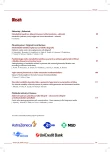Impact of body weight on the risk of venous thromboembolism
Authors:
T. Petrovič; T. Koller; J. Payer
Authors‘ workplace:
V. interná klinika Lekárskej fakulty UK a FNsP Bratislava-Ružinov, Slovenská republika, prednosta prof. MUDr. Juraj Payer, CSc.
Published in:
Vnitř Lék 2009; 55(2): 106-110
Category:
Original Contributions
Overview
Introduction:
Obesity and venous thromboembolism represent a serious medical problem.
Material and methods:
Their mutual relationship was studied on the group of 124 patients with venous thromboembolism (the study group) and was compared to the group of 124 randomly chosen controls among hospitalized patients matched for age, sex and risk factor profile of venous thromboembolism (the control group).
Results:
Recorded variables were body weight, presence of arterial hypertension, hypertriglyceridemia and type 2 diabetes or impaired glucose tolerance. We found significantly higher prevalence of obesity – 40 vs 23 patients (38.5% vs 23%, p = 0.0283) and significantly higher BMI (29.254 vs 26.923, p = 0.002) in the study group. Increased body weight was found to be the only significant risk factor for venous thromboembolism (odds ratio = 2.507, p = 0.0026) and normal body weight was the only protective factor (odds ratio = 0.3989, p = 0.0026). We equally found the significant increase of the prevalence of venous thromboembolism with increasing body weight (p = 0.020). Even in patients without known risk factors for venous thromboembolism (n = 55) we found significantly higher prevalence of increased body weight (BMI > 25) in the study group (82.4% vs 61.2%, p = 0.0221). No other recorded variable was significantly more frequent in the study group.
Conclusion:
Reduction of body weight could therefore represent an important challenge in preventing the venous thromboembolism.
Key words:
venous tromboembolism – body weight – metabolic syndrom
Sources
1. Juhan-Vague I, Morange PE, Alessi MC. The insulin resistance syndrome: implications for thrombosis and cardiovascular disease. Pathophysiol Haemost Thromb 2002; 32 : 269–273.
2. Remková A. Protrombotický stav ako súčasť metabolického syndrómu. Vnitř Lék 2005; 51 : 1120–1125.
3. Remková A. Hypertenzia a hemostáza. Bratislava: Slovak Academic Press 1998.
4. Giandomenico G, Dellas C, Czekay RP et al. The leptin receptor system of human platelets. J Thromb Haemost 2005; 3 : 1042–1049.
5. Hori Y, Gabazza EC, Yano Y et al. Insulin resistance is associated with increased circulating level of thrombin‑activatable fibrinolysis inhibitor in type 2 diabetic patients. J Clin Endocrinol Metab 2002; 87 : 660–665.
6. Erem C, Hacihasanoğlu A, Çelik S et al. Coagulation and fibrinolysis parameters in type 2 diabetic patients with and without diabetic vascular complications. Med Princ Pract 2005; 14 : 22–30.
7. Aso Y, Wakabayashi S, Yamamoto R et al. Metabolic syndrome accompanied by hypercholesterolemia is strongly associated with proinflammatory state and impairment of fibrinolysis in patients with type 2diabetes: synergistic effects of plasminogen activator inhibitor-1 and thrombin‑activatable fibrinolysis inhibitor. Diabetes Care 2005; 28 : 2211–2216.
8. Juhan-Vague I, Alessi MC, Mavri A, Morange PE. Plasminogen activator inhibitor-1, inflammation, obesity, insulin resistance and vascular risk. J Thromb Haemost 2003; 1 : 1575–1579.
9. Vayá A, Mira Y, Ferrando F et al. Hyperlipidaemia and venous thromboembolism in patients lacking thrombophilic risk factors. Br J Haematol 2002; 118 : 255–259.
10. Stein PD, Beemath A, Olson RE. Obesity as a risk factor in venous thromboembolism. Am J Med 2005; 118 : 978–980.
11. Petrauskiene V, Falk M, Waernbaum I et al. The risk of venous thromboembolism is markedly elevated in patients with diabetes. Diabetologia 2005; 48 : 1017–1021.
12. Tsai AW, Cushman M, Rosamond WD et al. Cardiovascular risk factors and venous thromboembolism incidence: the longitudinal investigation of thromboembolism etiology. Arch Intern Med 2002; 162 : 1182–1189.
13. Lacut K, Oger E, Le Gal G et al. Statins but not fibrates are associated with a reduced risk of venous thromboembolism: a hospital‑based case-control study. Fundam Clin Pharmacol 2004; 18 : 477–482.
14. Ageno W, Becattini C, Brighton T et al. Cardiovascular risk factors and venous thromboembolism: a meta‑analysis. Circulation 2008; 117 : 93–102.
15. Goldhaber SZ, Grodstein F, Stampfer MJ et al. A prospective study of risk factors for pulmonary embolism in women. JAMA 1997; 277 : 642–645.
16. Ay C, Tengler T, Vormittag R et al. Venous thromboembolism – a manifestation of the metabolic syndrome. Haematologica 2007; 92 : 374–380.
17. Ageno W, Prandoni P, Romualdi E et al. The metabolic syndrome and the risk of venous thrombosis: a case-control study. J Thromb Haemost 2006; 4 : 1914–1918.
Labels
Diabetology Endocrinology Internal medicineArticle was published in
Internal Medicine

2009 Issue 2
Most read in this issue
- Superficial thrombophlebitis – diagnostics and treatment
- Guidelines for duplex ultrasound exam of limb veins
- Aortic valve sparing operations and reconstruction – from anatomy to the long‑term results
- The combination of an ACE inhibitor and a calcium channel blocker is an optimal combination for the treatment of hypertension
